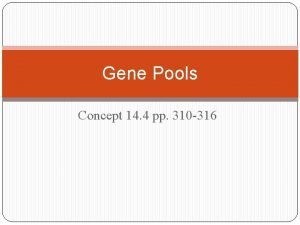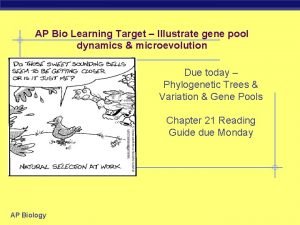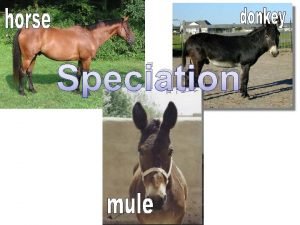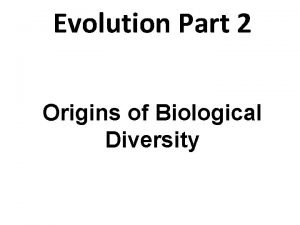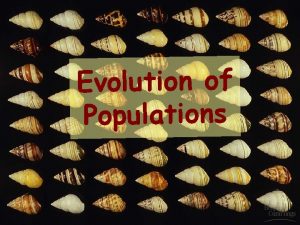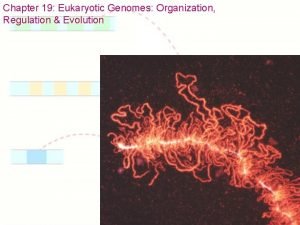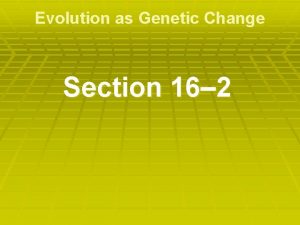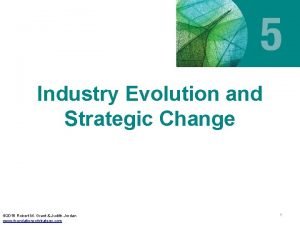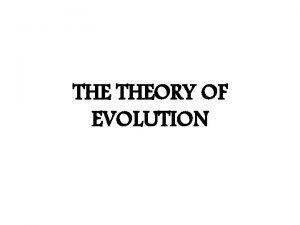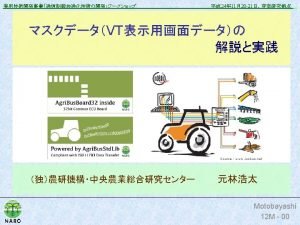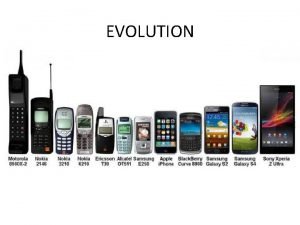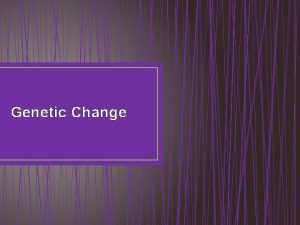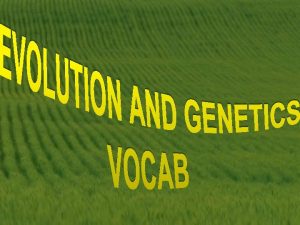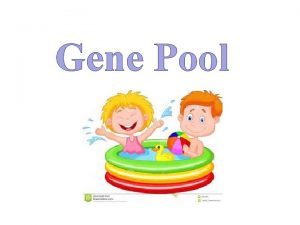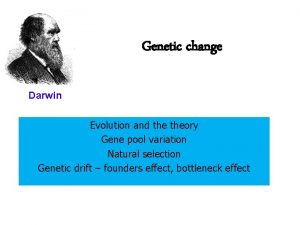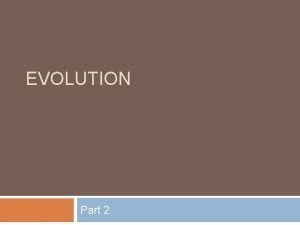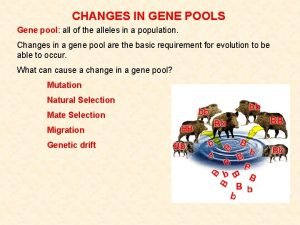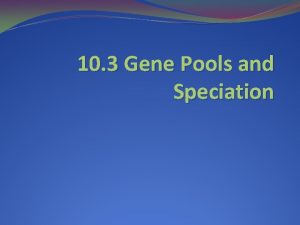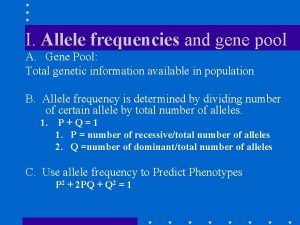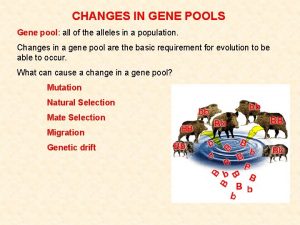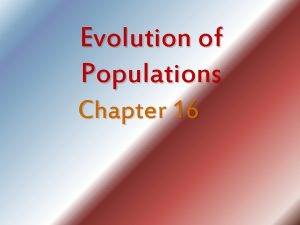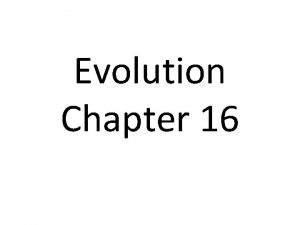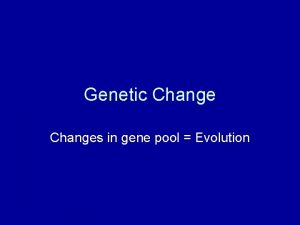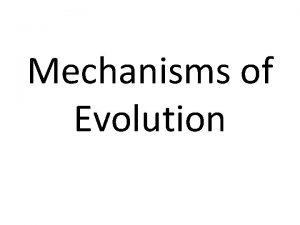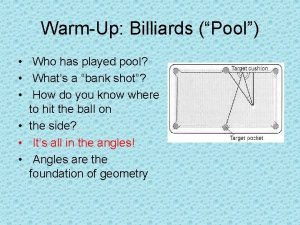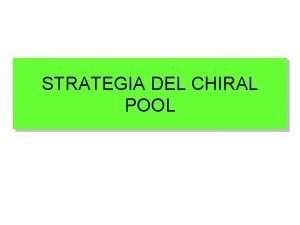Evolution Evolution The change in the gene pool































- Slides: 31

Evolution

Evolution • The change in the gene pool of a population from generation to generation. • It is important to remember that individuals do not evolve, populations evolve. • All the genes in a population are called the gene pool. • The ratio of different alleles in that population can change over time. • As the ratio changes, so evolution occurs.

Evolution • Modern evolution theories are a mixture of theories of Darwin together with new evidence from our knowledge of genetics, fossil records, comparative anatomy, physiology and biochemistry.

Cuvier (1769 – 1832)

Cuvier (1769 – 1832) • This French anatomist is largely responsible for the development of Palaeontology. • He recorded the succession of fossils in the Paris Basin. • He recognised that the fossils of simpler organisms were in the oldest rock strata, and that there were many extinctions. • Cuvier believed that species were fixed.

Cuvier (1769 – 1832) • He thought that the boundries between strata were caused by catastrophes like drought, fires and floods. • Cuvier thought that the effects of extinctions were probably localised and that after the catastrophe passed, new organisms from the surrounding areas would repopulate the area. • Called Catastrophism.

Lamarck (1774 – 1829) • In 1809 Lamarck proposed that organisms could gradually bring about changes in themselves to suit the environment and that these changes could be passed on to their offspring. • This was known as the “Inheritance of acquired characteristics”

Lamarck (1774 – 1829) • As far as we now know this is not possible as changes in somatic cells can not be passed on to offspring.


Darwin (1809 – 1882)

Darwin (1809 – 1882) • Charles Robert Darwin is known as the “Father of Evolution” • He thought that there was a unity of life, and that all organisms were related through a common ancestor. • He thought similar things could be grouped together, he used Linnaeus’ taxonomy to group his organisms together.

Darwin (1809 – 1882) • Darwin showed that species do not remain unchanged over time.


Darwin’s Reasoning • All organisms have a high reproductive rate, but food supply and other essentials are limited leading to a struggle for existence amongst the offspring. • There is genetic variation amongst the offspring and some are better adapted for survival.

Darwin’s Reasoning • Organisms with these variations will survive longer and reproduce. • Over time, each progressive generation will be better adapted to the environment. “Survival of the Fittest”. • Eventually, new species will evolve from old ones. This is called “Natural Selection”.

Sources of Heritable Variation • The only things that can cause variation are mutations and sexual recombination.

Mutations • The only source of new alleles is mutation. • These mutations are rare and random. • Only a mutation in cell lines which lead to the formation of gametes are passed on. • These are usually harmful and are normally carried in the recessive condition. • Occasionally a mutation is good for adaptation to an environment – it may be an advantage to offspring.

Mutation • Over a long period of time these advantageous mutations may become established in the population.

Sexual Recombination • During meiosis the homologous chromosomes line up at the equator of the spindle in pairs, with one going to each end of the cell. • In humans there are 223 (8 388 608) possible combinations of chromosomes in a gamete. • Sexual reproduction then mixes these gametes with those from another person who has also had his chromosomes separated randomly

Sexual Recombination • To increase the variation of genes, the swapping of pieces of chromosomes in crossing over at meiosis leads to even greater differences.

Agents that Change Gene Frequency • Natural Selection some combinations of alleles are more likely to help survival and reproduction thus their frequency in the gene pool will steadily increase form one generation to the next.

Agents that Change Gene Frequency • all populations has a large range of phenotypes, which usually fall into a normal distribution curve. The selective forces such as predators, competition, disease, food, light, water, climate etc act on the phenotypes as follows: v. Stabilising selection v. Directional Selection v. Disruptive Selection

Stabilising Selection This favours the average over the extremes.

Directional Selection This favours one extreme over the average and other extreme.

Disruptive Selection This favours both extremes over the average.

Agents that Change Gene Frequency Genetic Drift • This occurs in small populations • It can cause evolution by chance fluctuations in the gene pool of a small population. • It is the change in the gene pool of a small population due to chance.

Genetic Drift

Founder Effect this is due to a limited no of ancestors.

The Founder Effect

Agents that Change Gene Frequency Mutation this is the ultimate source of variation. Gene Migration (immigration and emigration) when immigrants arrive form another population with a different gene pool, new alleles are introduced. NB mutation and immigration increase genetic variety, natural selection, emigration and genetic drift decrease it.

 Gene pool definition biology
Gene pool definition biology Gene pool ap bio
Gene pool ap bio Genetic drift vs genetic flow
Genetic drift vs genetic flow Genetic drift definition biology
Genetic drift definition biology Individuals don't evolve populations do
Individuals don't evolve populations do Genetic drift คือ
Genetic drift คือ Gene pool
Gene pool What is a gene pool
What is a gene pool Gene by gene test results
Gene by gene test results Chapter 17 gene expression from gene to protein
Chapter 17 gene expression from gene to protein Gene evolution
Gene evolution 16-2 evolution as genetic change
16-2 evolution as genetic change Industry evolution and strategic change
Industry evolution and strategic change Slow evolution
Slow evolution What is a physical change
What is a physical change Evidence of chemical change
Evidence of chemical change Absolute change and relative change formula
Absolute change and relative change formula What are integers
What are integers Difference in physical and chemical changes
Difference in physical and chemical changes A change in supply vs a change in quantity supplied
A change in supply vs a change in quantity supplied Change in supply and change in quantity supplied
Change in supply and change in quantity supplied Enagic founder
Enagic founder Reactive change is change that
Reactive change is change that Physical and chemical changes examples
Physical and chemical changes examples Spare change physical versus chemical change
Spare change physical versus chemical change Rocks change due to temperature and pressure change
Rocks change due to temperature and pressure change Whats the difference between a physical and chemical change
Whats the difference between a physical and chemical change When does a physical change occur study jams
When does a physical change occur study jams Physical or chemical change
Physical or chemical change First order vs second order change
First order vs second order change Why is chopping wood a physical change
Why is chopping wood a physical change Climate change 2014 mitigation of climate change
Climate change 2014 mitigation of climate change
